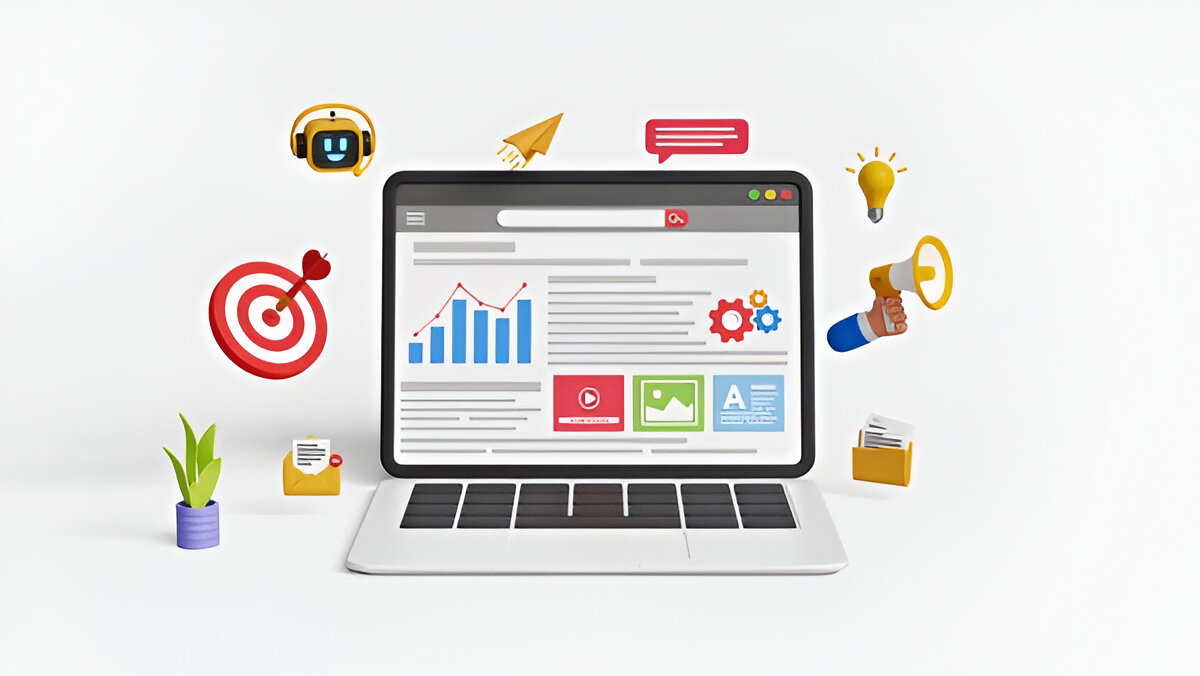Marketing automation has revolutionized how businesses attract, engage, and convert potential customers. When combined with inbound marketing strategies, automation becomes a powerful engine that nurtures leads while you focus on creating valuable content and building meaningful relationships.
Whether you’re new to marketing automation or looking to optimize your existing setup, you’ll find actionable insights and proven strategies to transform your inbound marketing results.
What is Marketing Automation for Inbound?

Marketing automation for inbound refers to using technology platforms to automatically execute, manage, and nurture your inbound marketing activities. Unlike outbound marketing that interrupts potential customers, inbound marketing automation works behind the scenes to deliver the right content to the right people at the right time.
The foundation of effective inbound automation lies in understanding your buyer’s journey. As prospects move from awareness to consideration to decision-making, automated systems can trigger personalised communications, score leads based on behaviour, and seamlessly hand off qualified prospects to your sales team.
This approach transforms your marketing from a one-size-fits-all broadcast into a sophisticated, personalized experience that feels natural and helpful rather than pushy or intrusive.
Core Benefits of Inbound Marketing Automation
Improved Lead Nurturing
Automated lead nurturing allows you to stay connected with prospects throughout their entire buyer journey. Instead of hoping they remember your brand when they’re ready to purchase, you can deliver valuable content that keeps you top-of-mind while building trust and expertise.
Email sequences can be triggered by specific actions—downloading an ebook, visiting pricing pages, or attending a webinar. These touchpoints provide relevant information exactly when prospects need it most.
Enhanced Lead Scoring and Qualification
Marketing automation platforms track every interaction prospects have with your brand. Website visits, email opens, content downloads, and social media engagement all contribute to comprehensive lead scoring models.
This data helps your sales team focus on the most qualified prospects while allowing marketing to continue nurturing leads that aren’t quite ready to buy. The result is higher conversion rates and more efficient use of sales resources.
Personalized Customer Experiences
Automation enables mass personalization at scale. Dynamic content adapts based on visitor behavior, industry, company size, or previous interactions. Email campaigns can automatically adjust subject lines, content, and calls-to-action based on recipient preferences and actions.
This level of personalization creates more engaging experiences that feel individually crafted, even when delivered to thousands of contacts simultaneously.
Scalable Growth
As your business grows, manually managing every lead interaction becomes impossible. Marketing automation scales your efforts without requiring proportional increases in staff. You can nurture hundreds or thousands of leads simultaneously while maintaining consistent, high-quality touchpoints.
Essential Components of Inbound Marketing Automation
Email Marketing Automation
Email remains one of the most effective inbound marketing channels. Automated email workflows can welcome new subscribers, nurture leads through educational content series, re-engage inactive contacts, and celebrate customer milestones.
Successful email automation goes beyond basic drip campaigns. Advanced segmentation allows you to create highly targeted sequences based on demographics, behaviour, and engagement patterns. A/B testing capabilities help optimize subject lines, send times, and content for maximum impact.
Lead Scoring Systems
Effective lead scoring combines demographic information with behavioral data to identify sales-ready prospects. Points are assigned for actions like visiting key pages, downloading resources, or requesting demos.
The most sophisticated systems use negative scoring to identify disqualified leads—such as competitors or job seekers—preventing sales teams from wasting time on poor-fit prospects.
Content Personalization
Dynamic content ensures every visitor sees information relevant to their interests and needs. Website personalization can highlight industry-specific case studies, adjust messaging based on company size, or showcase products relevant to previous browsing behavior.
This extends to landing pages, where form fields can pre-populate with known information, reducing friction and improving conversion rates.
Social Media Integration
Marketing automation platforms can schedule and publish social media content, monitor brand mentions, and track social engagement metrics. More advanced features include social listening capabilities that identify potential leads based on relevant conversations and keywords.
Analytics and Reporting
Comprehensive reporting shows which automated campaigns drive the best results. Track metrics like open rates, click-through rates, conversion rates, and revenue attribution across all automated touchpoints.
These insights help optimize campaigns, identify successful content types, and demonstrate marketing’s impact on business growth.
Setting Up Your Inbound Marketing Automation Strategy
Define Your Buyer Personas
Successful automation starts with a deep understanding of your target audience. Create detailed buyer personas that include demographics, pain points, goals, preferred communication channels, and buying behaviour patterns.
These personas guide automation decisions—from email frequency to content topics to lead scoring criteria. The more specific your personas, the more targeted and effective your automated campaigns become.
Map the Customer Journey
Document every stage of your buyer’s journey, from initial awareness through post-purchase advocacy. Identify the questions prospects ask, the content they need, and the actions they typically take at each stage.
This mapping reveals automation opportunities—welcome sequences for new visitors, educational content for early-stage prospects, and comparison guides for decision-stage buyers.
Choose the Right Platform
Select a marketing automation platform that aligns with your business size, technical requirements, and budget. Consider factors like ease of use, integration capabilities, scalability, and customer support quality.
Popular platforms include HubSpot, Marketo, Pardot, and ActiveCampaign. Each offers different strengths—some excel at email marketing, others at lead scoring, and some provide comprehensive all-in-one solutions.
Create Automated Workflows
Start with simple workflows and gradually increase complexity. Begin with basic email sequences triggered by form submissions or content downloads. As you gain experience, add behavioral triggers, conditional logic, and multi-channel campaigns.
Document each workflow’s purpose, target audience, success metrics, and optimization opportunities. This documentation helps team members understand the automation strategy and facilitates future improvements.
Best Practices for Inbound Marketing Automation
Focus on Value First
Every automated touchpoint should provide genuine value to recipients. Avoid overly promotional content in favour of educational resources, industry insights, and helpful tools.
This value-first approach builds trust and positions your brand as a helpful resource rather than just another vendor trying to make a sale.
Maintain Human Connection
Automation should enhance, not replace, human interaction. Include options for prospects to speak with real people, respond to automated emails with personal messages when appropriate, and ensure sales handoffs feel warm and personal.
The goal is using automation to scale personal attention, not eliminate it entirely.
Test and Optimize Continuously
Regular testing and optimization separate good automation from great automation. Test email subject lines, send times, content formats, and call-to-action buttons. Even small improvements can significantly impact overall performance.
Set up systematic testing schedules and document results to build institutional knowledge about what works best for your audience.
Segment Thoughtfully
Broad, generic automation campaigns rarely achieve optimal results. Segment your audience based on industry, company size, role, behavior, and engagement level. Create specific campaigns for each segment that address their unique needs and challenges.
Start with basic segments and refine as you gather more data about your audience preferences and behavior patterns.
Common Pitfalls and How to Avoid Them
Over-Automation
Resist the temptation to automate everything immediately. Start simple and add complexity gradually. Too much automation too quickly can overwhelm your team and create poor user experiences.
Focus on automating high-impact, repetitive tasks first—welcome emails, lead nurturing sequences, and basic lead scoring. Add advanced features once foundational automation is working smoothly.
Ignoring Data Quality
Automation amplifies existing data problems. Clean, accurate contact information is essential for effective automated campaigns. Implement data hygiene processes, regularly audit contact lists, and establish clear data entry standards.
Poor data quality leads to embarrassing personalization errors, low deliverability rates, and wasted automation efforts.
Setting and Forgetting
Marketing automation requires ongoing attention and optimization. Regularly review campaign performance, update content, and adjust workflows based on changing business needs and customer feedback.
Schedule monthly automation reviews to identify improvement opportunities and ensure campaigns remain aligned with business goals.
Measuring Success and ROI

Key Performance Indicators
Track metrics that align with business objectives rather than vanity metrics. Important KPIs include lead quality scores, conversion rates from lead to customer, customer acquisition cost, and revenue attribution from automated campaigns.
Monitor engagement metrics like email open rates and click-through rates, but focus on how these contribute to business outcomes.
Attribution Modeling
Implement proper attribution modeling to understand how automated touchpoints contribute to conversions. Multi-touch attribution provides clearer pictures of customer journeys and helps optimize automation strategies.
This data helps justify automation investments and guide budget allocation across different automation initiatives.
Continuous Improvement Framework
Establish regular review cycles for automation performance. Monthly tactical reviews focus on campaign optimization, while quarterly strategic reviews assess overall automation strategy alignment with business goals.
Use these reviews to identify successful tactics for scaling and unsuccessful approaches for elimination or improvement.
Transform Your Marketing with Strategic Automation
Marketing automation for inbound marketing represents a powerful opportunity to scale personalized experiences while improving lead quality and conversion rates. Success requires thoughtful planning, continuous optimization, and maintaining the human connection that makes inbound marketing effective.
Start with clear goals, simple workflows, and strong foundational elements like buyer personas and customer journey mapping. As you gain experience and confidence, gradually add complexity and advanced features.
Remember that automation is a tool to enhance your marketing strategy, not replace strategic thinking and creativity. Focus on providing value, maintaining authentic relationships, and continuously improving based on data and feedback.
Ready to implement marketing automation for your inbound strategy? Begin by auditing your current processes, identifying high-impact automation opportunities, and selecting the right platform for your needs. With proper planning and execution, marketing automation can transform your inbound marketing results and accelerate business growth.




